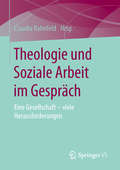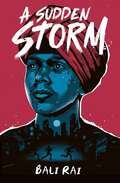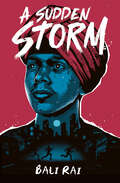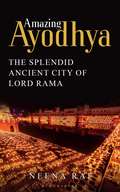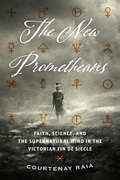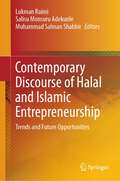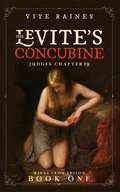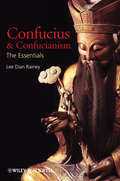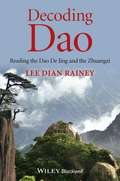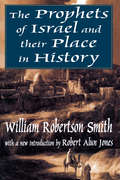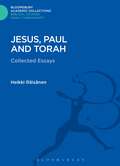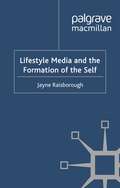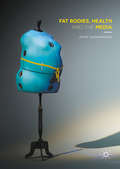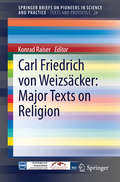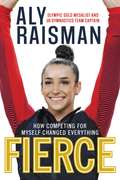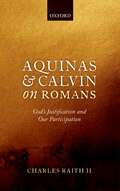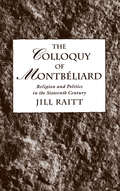- Table View
- List View
Theologie und Soziale Arbeit im Gespräch: Eine Gesellschaft – viele Herausforderungen
by Claudia RahnfeldDer Band thematisiert aus verschiedenen Perspektiven mögliche Schnittstellen von Theologie und Sozialer Arbeit. Ausgangspunkt sind aktuelle gesellschaftliche Krisensituationen und soziale Problemlagen. Die Beiträge zeigen wie wichtig ein fächer-, konfessions- und religionsübergreifender Zugang zu unterschiedlichsten gesellschaftlichen Herausforderungen sein muss, um angemessene Antworten zu finden.Der InhaltGrundlagentheoretische Perspektiven • Politische Auseinandersetzungen • Perspektiven auf Migration und Integration • Handlungstheoretische Modelle und ZugängeDie HerausgeberinProf. Dr. Claudia Rahnfeld lehrt und forscht an der Dualen Hochschule Gera-Eisenach im Fachbereich Sozialwesen.
A Sudden Storm
by Bali RaiAn innocent night out to celebrate his sixteenth birthday turns to tragedy when Arjan is targeted by a group of racist thugs, who single him out for the colour of his skin and the turban that he wears.
Amazing Ayodhya: The Splendid Ancient City of Lord Rama
by Neena RaiHow big was the ancient city of Ayodhya? Why is this city so significant for Hindus? Who established the city and what did it look like? What did Lord Rama and Devi Sita's palace look like? What sort of animals were found in this ancient land? No one grows up in India untouched by the beautiful story of Lord Rama and Devi Sita. Every Dussehra we celebrate the victory of Rama over Ravana, the victory of good over evil. Every Deepavali, we commemorate the return of Rama and Sita to Ayodhya and hear the tale of how the entire city was lit up to receive their beloved king and queen. But is the magnificent capital of Ayodhya just limited to this? Ayodhya was a renowned pilgrimage destination since the dawn of mankind, and after the birth of Lord Rama, it became a place of supreme importance for Hindus. Amazing Ayodhya is an attempt in gaining knowledge about this ancient city-its architecture, its design, its buildings and all the splendid details during the era when Lord Rama walked this earth. This splendidly researched book, replete with shlokas from the Valmiki Ramayana, offers authentic information about the city which will not only help understand the life and times of ancient Hindus but also the revered figures of Rama and Sita. Replete with descriptions, author Neena Rai draws out comparisons of an earlier era with our current life and culture, thus connecting the past with the present. She further compares Ayodhya with the cultures of other ancient civilisations so that the reader feels 'connected' to the past and the content of the book appears 'contemporary'. A fascinating account of an ancient city with significant contemporary relevance, Amazing Ayodhya is a must-read for a better understanding of history, scriptures and Hindu civilisation.
The New Prometheans: Faith, Science, and the Supernatural Mind in the Victorian Fin de Siècle
by Courtenay RaiaThe Society for Psychical Research was established in 1882 to further the scientific study of consciousness, but it arose in the surf of a larger cultural need. Victorians were on the hunt for self-understanding. Mesmerists, spiritualists, and other romantic seekers roamed sunken landscapes of entrancement, and when psychology was finally ready to confront these altered states, psychical research was adopted as an experimental vanguard. Far from a rejected science, it was a necessary heterodoxy, probing mysteries as diverse as telepathy, hypnosis, and even séance phenomena. Its investigators sought facts far afield of physical laws: evidence of a transcendent, irreducible mind. The New Prometheans traces the evolution of psychical research through the intertwining biographies of four men: chemist Sir William Crookes, depth psychologist Frederic Myers, ether physicist Sir Oliver Lodge, and anthropologist Andrew Lang. All past presidents of the society, these men brought psychical research beyond academic circles and into the public square, making it part of a shared, far-reaching examination of science and society. By layering their papers, textbooks, and lectures with more intimate texts like diaries, letters, and literary compositions, Courtenay Raia returns us to a critical juncture in the history of secularization, the last great gesture of reconciliation between science and sacred truths.
The New Prometheans: Faith, Science, and the Supernatural Mind in the Victorian Fin de Siècle
by Courtenay RaiaThe Society for Psychical Research was established in 1882 to further the scientific study of consciousness, but it arose in the surf of a larger cultural need. Victorians were on the hunt for self-understanding. Mesmerists, spiritualists, and other romantic seekers roamed sunken landscapes of entrancement, and when psychology was finally ready to confront these altered states, psychical research was adopted as an experimental vanguard. Far from a rejected science, it was a necessary heterodoxy, probing mysteries as diverse as telepathy, hypnosis, and even séance phenomena. Its investigators sought facts far afield of physical laws: evidence of a transcendent, irreducible mind. The New Prometheans traces the evolution of psychical research through the intertwining biographies of four men: chemist Sir William Crookes, depth psychologist Frederic Myers, ether physicist Sir Oliver Lodge, and anthropologist Andrew Lang. All past presidents of the society, these men brought psychical research beyond academic circles and into the public square, making it part of a shared, far-reaching examination of science and society. By layering their papers, textbooks, and lectures with more intimate texts like diaries, letters, and literary compositions, Courtenay Raia returns us to a critical juncture in the history of secularization, the last great gesture of reconciliation between science and sacred truths.
The New Prometheans: Faith, Science, and the Supernatural Mind in the Victorian Fin de Siècle
by Courtenay RaiaThe Society for Psychical Research was established in 1882 to further the scientific study of consciousness, but it arose in the surf of a larger cultural need. Victorians were on the hunt for self-understanding. Mesmerists, spiritualists, and other romantic seekers roamed sunken landscapes of entrancement, and when psychology was finally ready to confront these altered states, psychical research was adopted as an experimental vanguard. Far from a rejected science, it was a necessary heterodoxy, probing mysteries as diverse as telepathy, hypnosis, and even séance phenomena. Its investigators sought facts far afield of physical laws: evidence of a transcendent, irreducible mind. The New Prometheans traces the evolution of psychical research through the intertwining biographies of four men: chemist Sir William Crookes, depth psychologist Frederic Myers, ether physicist Sir Oliver Lodge, and anthropologist Andrew Lang. All past presidents of the society, these men brought psychical research beyond academic circles and into the public square, making it part of a shared, far-reaching examination of science and society. By layering their papers, textbooks, and lectures with more intimate texts like diaries, letters, and literary compositions, Courtenay Raia returns us to a critical juncture in the history of secularization, the last great gesture of reconciliation between science and sacred truths.
The New Prometheans: Faith, Science, and the Supernatural Mind in the Victorian Fin de Siècle
by Courtenay RaiaThe Society for Psychical Research was established in 1882 to further the scientific study of consciousness, but it arose in the surf of a larger cultural need. Victorians were on the hunt for self-understanding. Mesmerists, spiritualists, and other romantic seekers roamed sunken landscapes of entrancement, and when psychology was finally ready to confront these altered states, psychical research was adopted as an experimental vanguard. Far from a rejected science, it was a necessary heterodoxy, probing mysteries as diverse as telepathy, hypnosis, and even séance phenomena. Its investigators sought facts far afield of physical laws: evidence of a transcendent, irreducible mind. The New Prometheans traces the evolution of psychical research through the intertwining biographies of four men: chemist Sir William Crookes, depth psychologist Frederic Myers, ether physicist Sir Oliver Lodge, and anthropologist Andrew Lang. All past presidents of the society, these men brought psychical research beyond academic circles and into the public square, making it part of a shared, far-reaching examination of science and society. By layering their papers, textbooks, and lectures with more intimate texts like diaries, letters, and literary compositions, Courtenay Raia returns us to a critical juncture in the history of secularization, the last great gesture of reconciliation between science and sacred truths.
The New Prometheans: Faith, Science, and the Supernatural Mind in the Victorian Fin de Siècle
by Courtenay RaiaThe Society for Psychical Research was established in 1882 to further the scientific study of consciousness, but it arose in the surf of a larger cultural need. Victorians were on the hunt for self-understanding. Mesmerists, spiritualists, and other romantic seekers roamed sunken landscapes of entrancement, and when psychology was finally ready to confront these altered states, psychical research was adopted as an experimental vanguard. Far from a rejected science, it was a necessary heterodoxy, probing mysteries as diverse as telepathy, hypnosis, and even séance phenomena. Its investigators sought facts far afield of physical laws: evidence of a transcendent, irreducible mind. The New Prometheans traces the evolution of psychical research through the intertwining biographies of four men: chemist Sir William Crookes, depth psychologist Frederic Myers, ether physicist Sir Oliver Lodge, and anthropologist Andrew Lang. All past presidents of the society, these men brought psychical research beyond academic circles and into the public square, making it part of a shared, far-reaching examination of science and society. By layering their papers, textbooks, and lectures with more intimate texts like diaries, letters, and literary compositions, Courtenay Raia returns us to a critical juncture in the history of secularization, the last great gesture of reconciliation between science and sacred truths.
The New Prometheans: Faith, Science, and the Supernatural Mind in the Victorian Fin de Siècle
by Courtenay RaiaThe Society for Psychical Research was established in 1882 to further the scientific study of consciousness, but it arose in the surf of a larger cultural need. Victorians were on the hunt for self-understanding. Mesmerists, spiritualists, and other romantic seekers roamed sunken landscapes of entrancement, and when psychology was finally ready to confront these altered states, psychical research was adopted as an experimental vanguard. Far from a rejected science, it was a necessary heterodoxy, probing mysteries as diverse as telepathy, hypnosis, and even séance phenomena. Its investigators sought facts far afield of physical laws: evidence of a transcendent, irreducible mind. The New Prometheans traces the evolution of psychical research through the intertwining biographies of four men: chemist Sir William Crookes, depth psychologist Frederic Myers, ether physicist Sir Oliver Lodge, and anthropologist Andrew Lang. All past presidents of the society, these men brought psychical research beyond academic circles and into the public square, making it part of a shared, far-reaching examination of science and society. By layering their papers, textbooks, and lectures with more intimate texts like diaries, letters, and literary compositions, Courtenay Raia returns us to a critical juncture in the history of secularization, the last great gesture of reconciliation between science and sacred truths.
Contemporary Discourse of Halal and Islamic Entrepreneurship: Trends and Future Opportunities
by Lukman Raimi Salisu Monsuru Adekunle Muhammad Salman ShabbirThis book serves as a valuable resource for Islamic entrepreneurship researchers, Halal scholars, Islamic finance professionals, Halal advocates, and Halal business model consultants in the fast-changing global economy. The thematic focus is not only on Islamic and halal entrepreneurship but also on halal production and consumption, ethics and impact investing in Islamic entrepreneurship, Shariah principles guiding business model innovation and utilisation of disruptive technologies (such as crowdfunding for startups, bitcoin, digital ventures, cryptocurrency, blockchain, among others), Islamic entrepreneurship and SDGs, halalisation and sustainability issues, and emergence of Islamic-Fintech in Muslim majority nations and nations with plural economic systems, including the interface of Islamic and halal entrepreneurship with science, technology, engineering, and mathematics (STEM). At the moment, the working knowledge about Islamic and halal entrepreneurship is at its infancy among Islamic finance professionals, halal consultants, academic researchers, and students nursing the ambition of going into these two fields. Universities, Islamic training academies, and centres are also ill equipped to enrich Islamic and halal curricula with principles and conventional models. One of the proactive ways of breaking financial exclusion, social inequality, and social exclusion caused by apathy and avoidance of Riba, Maysir, and Gharar is by recognising, embracing, and promoting Islamic and halal entrepreneurship among the excluded Muslims and lovers of ethical business models. Overall, this book aims to promote better understanding of Islamic and Halal entrepreneurship in order to assist academics, researchers, practitioners, consultants, and policymakers to improve the growth of Islamic startups and small and medium enterprises (SMEs) by improving social inclusion and financial inclusion and accelerating the attainment of SDG 8 and SDG12.
The Levite's Concubine: Judges Chapter 19
by Viye RainesViye Raines' novel The Levite’s Concubine is an engrossing retelling of the most bizarre and savage chapter in the Hebrew Bible — Judges Chapter 19.Told with striking historical detail, one of the most ancient parts of the Old Testament comes alive, opening with the concubine fleeing her master and closing with the her startling and unforgettable destruction.Affecting and intimate, unrestrained and ghastly, The Levite's Concubine combines rich storytelling with an original insight into Biblical history and women's roles in a compelling time and place — about 1000 years BCE — in the land that would become Israel.Although the story told in Judges Chapter 19 is violent, it ultimately takes our attention because of its treatment of women. Not only does it feature as its central act a vicious molestation of an innocent woman, it is also a part of a religious text. This text, our Hebrew Bible, is not just central to Jewish and Christian civilisation, but also to their worship, and is held by nearly a third of the people of the planet to be spiritually significant.
Confucius and Confucianism: The Essentials
by Lee Dian RaineyThis comprehensive introduction explores the life and teachings of Confucius, and development of Confucian thought, from ancient times to the present today. Demonstrates the wisdom and enduring relevance of Confucius’s teachings – drawing parallels between our 21st century society and that of China 2,500 years ago, where government corruption, along with social, economic, and technical changes, led thinkers to examine human nature and society Draws on the latest research and incorporates interpretations of Confucius and his works by Chinese and Western scholars throughout the centuries Explores how Confucius's followers expanded and reinterpreted his ideas after his death, and how this process has continued throughout Chinese history Seamlessly links Confucius with our modern age, revealing how his teachings have become the basis of East Asian culture and influenced the West
Decoding Dao: Reading the Dao De Jing (Tao Te Ching) and the Zhuangzi (Chuang Tzu)
by Lee Dian RaineyWritten by a leading authority on Chinese philosophy, Decoding Dao uniquely focuses on the core texts in Daoist philosophy, providing readers with a user-friendly introduction that unravels the complexities of these seminal volumes. Offers a detailed introduction to the core texts in Daoist philosophy, the Dao De Jing and the Zhuangzi, two of the most widely read – and most challenging – texts in China’s long literary history Covers the three main ways the texts can be read: as religious, mystical, and philosophical works Explores their historical context, origins, authorship, and the reasons these seminal texts came into being, along with the key terms and approaches they take Examines the core philosophical arguments made in the texts, as well as the many ways in which they have been interpreted, both in China itself and in the West Provides readers with an unrivalled insight into the multifaceted philosophy of Daoism – and the principles underlying much of Chinese culture – informed by the very latest academic scholarship
Decoding Dao: Reading the Dao De Jing (Tao Te Ching) and the Zhuangzi (Chuang Tzu)
by Lee Dian RaineyWritten by a leading authority on Chinese philosophy, Decoding Dao uniquely focuses on the core texts in Daoist philosophy, providing readers with a user-friendly introduction that unravels the complexities of these seminal volumes. Offers a detailed introduction to the core texts in Daoist philosophy, the Dao De Jing and the Zhuangzi, two of the most widely read – and most challenging – texts in China’s long literary history Covers the three main ways the texts can be read: as religious, mystical, and philosophical works Explores their historical context, origins, authorship, and the reasons these seminal texts came into being, along with the key terms and approaches they take Examines the core philosophical arguments made in the texts, as well as the many ways in which they have been interpreted, both in China itself and in the West Provides readers with an unrivalled insight into the multifaceted philosophy of Daoism – and the principles underlying much of Chinese culture – informed by the very latest academic scholarship
The Prophets of Israel and their Place in History: To The Close Of The Eighth Century B. C
by Lee RainwaterIn the history of nineteenth-century religious thought, William Robertson Smith occupies an ambiguous position. More than any other writer, he stimulated the theories of religion later advanced by Frazer, Durkheim, and Freud. Smith himself was not an original scholar, but was rather ""clever at presenting other men's theories"" within new and sometimes hostile contexts. Smith was an important contributor to two of the most serious challenges to Christian orthodoxy of the last century, the ""Higher Criticism"" of the Bible and the comparative study of religion, and was also the victim of the last successful heresy trial in Great Britain. Yet he was an utterly devout Protestant, whose views on Biblical criticism (for which he was damned) are now considered as true as his views on totemism and sacrifice (for which he was praised) are now considered false. Despite Smith's enormous significance for the history of religious ideas, he has been written about relatively little, and most of what we know about his life and work comes from a source almost a century old. Originally published in 1882, The Prophets of Israel is a collection of eight lectures, including ""Israel and Jehovah;"" ""Jehovah and the Gods of the Nations,"" ""Amos and the House of Jehu,"" ""Hosea and the Fall of Ephraim,"" ""The Kingdom of Judah and the Beginnings of Isaiah's Work,"" ""The Earlier Prophesies of Isaiah,"" ""Isaiah and Micah in the Reign of Hezekiah,"" and ""The Deliverance from Assyria.""A new introduction by Robert Alun Jones discusses Smith's early life, the heresy trial, Smith's early view of prophecy, and the classic text itself. The book will be of interest to students and teachers of religious studies, and general readers interested in Robertson Smith.
The Prophets of Israel and their Place in History
by Lee RainwaterIn the history of nineteenth-century religious thought, William Robertson Smith occupies an ambiguous position. More than any other writer, he stimulated the theories of religion later advanced by Frazer, Durkheim, and Freud. Smith himself was not an original scholar, but was rather ""clever at presenting other men's theories"" within new and sometimes hostile contexts. Smith was an important contributor to two of the most serious challenges to Christian orthodoxy of the last century, the ""Higher Criticism"" of the Bible and the comparative study of religion, and was also the victim of the last successful heresy trial in Great Britain. Yet he was an utterly devout Protestant, whose views on Biblical criticism (for which he was damned) are now considered as true as his views on totemism and sacrifice (for which he was praised) are now considered false. Despite Smith's enormous significance for the history of religious ideas, he has been written about relatively little, and most of what we know about his life and work comes from a source almost a century old. Originally published in 1882, The Prophets of Israel is a collection of eight lectures, including ""Israel and Jehovah;"" ""Jehovah and the Gods of the Nations,"" ""Amos and the House of Jehu,"" ""Hosea and the Fall of Ephraim,"" ""The Kingdom of Judah and the Beginnings of Isaiah's Work,"" ""The Earlier Prophesies of Isaiah,"" ""Isaiah and Micah in the Reign of Hezekiah,"" and ""The Deliverance from Assyria.""A new introduction by Robert Alun Jones discusses Smith's early life, the heresy trial, Smith's early view of prophecy, and the classic text itself. The book will be of interest to students and teachers of religious studies, and general readers interested in Robertson Smith.
Jesus, Paul and Torah: Collected Essays (The Library of New Testament Studies)
by Heikki RäisänenThis collection of major essays by the distinguished Finnish New Testament scholar will prove an invaluable sourcebook for students of this much-debated complex of problems.
Lifestyle Media and the Formation of the Self
by J. RaisboroughBe the best you can be' urge self-help books and makeover TV shows, but what kind of self is imagined as needing a makeover and what kind of self is imagined as the happy result? Drawing on recent sociology and psychology, this book explores the function of slummy mummies, headless zombies and living autopsies to creating an idea of self.
Fat Bodies, Health and the Media
by Jayne RaisboroughOur televisions bulge with weight-loss shows, as the news warn of the obesity epidemic. Fat is such a villain that larger people are stigmatized and we all are seduced by life-changing claims of a multi-billion pound diet industry. Yet, when we question if our bathroom scales can really tell us about our health, we start to ask just why and how fat holds such fascination.In this book, Jayne Raisborough explores interpretations of fat bodies from Palaeolithic Europe to Poverty Porn TV to argue that fat’s materiality makes it ripe for stigmatising associations. However, especially in a social context that presents health as a matter of choice, fat also emerges as an ideal redemptive substance to be pummelled and starved into submission. This book presents a ‘fat sensibility’ to demonstrate how fat is helping us all become responsibilised healthy-citizens. It asks just what self are we being asked to diet ourselves into?
Carl Friedrich von Weizsäcker: Major Texts On Religion (SpringerBriefs on Pioneers in Science and Practice #24)
by Konrad RaiserThis book presents a collection of texts by the German physicist and philosopher Carl Friedrich von Weizsäcker (1912-2007) in English, for use in seminars on the philosophy of religion, the comparative study of religion, but as well on the relationship between religion and the scientific worldview. Most texts appear in English for the first time. Weizsäcker became famous through his works in physics, mainly in the early development of nuclear physics. Later he would also become well known as a philosopher and analyst of contemporary culture. He also worked very intensely on projects for the prevention of nuclear war and for peace in general.
Fierce: How Competing for Myself Changed Everything
by Aly RaismanThe New York Times bestseller!Discover Aly Raisman's inspiring story of dedication, perseverance, and learning to think positive even in the toughest times on her path to gold medal success in two Olympic Games--and beyond. Aly Raisman first stepped onto a gymnastics mat as a toddler in a "mommy & me" gymnastics class. No one could have predicted then that sixteen years later, she'd be standing on an Olympic podium, having achieved her dreams. Aly's road to success was full of hard work, perseverance, and victories, but not without its hardships. Aly faced many obstacles, from naysayers who said she'd never make it in gymnastics to classmates who shamed her for her athletic body to a devastating betrayal of trust. Through it all, Aly surrounded herself with supportive family, friends, and teammates and found the inner strength to remain positive and believe in herself. Now, in her own words, Aly shows what it takes to be a champion on and off the floor, and takes readers on a behind-the-scenes journey before, during, and after her remarkable achievements in two Olympic Games--through her highest highs, lowest lows, and all the moments in between. Honest and heartfelt, frank and funny, Aly's story is enhanced with never-before-published photos, excerpts from the personal journals she's kept since childhood that chronicle memorable moments with her teammates, and hard-won advice for readers striving to rise above challenges, learn to love themselves, and make their own dreams come true.
Aquinas And Calvin On Romans: God's Justification And Our Participation
by Charles Raith IIAquinas and Calvin on Romans is a comparative study of John Calvin's and Thomas Aquinas's commentaries on the first eight chapters of Paul's letter to the Romans. Focusing on the role of human participation in God's work of salvation, Charles Raith argues that Calvin's critiques of the "schoolmen" arising from his reading of Romans fail to find a target in Aquinas's theology while Calvin's principal positive affirmations are embraced by Aquinas as well. Aquinas upholds many fundamental insights that Calvin would later also obtain in his reading of Romans, such as justification sola fide non merito (by faith alone and not by merit), the centrality of Christ for salvation, the ongoing imperfection of the sanctified life, the work of the Spirit guiding the believer along the path of sanctification, and the assurance of salvation that one obtains through the indwelling of the Spirit, to name only a few. Even more, numerous identical interpretations arising in their commentaries makes it necessary to consider Calvin's reading of Romans as appropriating a tradition of interpretation that includes Aquinas. At the same time, the nonparticipatory dimensions of Calvin's reading of Romans becomes clear when set beside Aquinas's reading, and these nonparticipatory dimensions create difficulties for Calvin's interpretation, especially on Romans 8, that are not present in Aquinas's account. Raith therefore suggests how Calvin's reading of Romans, especially as it pertains to justification and merit, should be augmented by the participatory framework reflected in Aquinas's interpretation. The book concludes by revisiting Calvin's criticisms of the Council of Trent in light of these suggestions.
The Colloquy of Montbéliard: Religion and Politics in the Sixteenth Century
by Jill RaittFocusing on the Colloquy of Montbéliard, a theological debate in 1586 between Lutherans and Calvinists, Raitt explores the complex array of shifting political alliances and religious tensions which characterized the Holy Roman Empire after the Peace of Augsburg. When the Wars of Religion broke out in France, both sides courted allies. Often these alliances involved confessional tests--most often concerning the Eucharist. Modern readers might expect that such complex theological questions belong in seminaries, but in many cases, they took place at the request of people and princes. On the outcome of these debates depended the well-being of towns and villages as well as the disposition of troops and the conduct of wars. Raitt's study of the "age of confessionalism" uncovers the background and details of the Colloquy of Monteb((e'))liard and analyzes the nature and implications of the underlying theological conflict.
